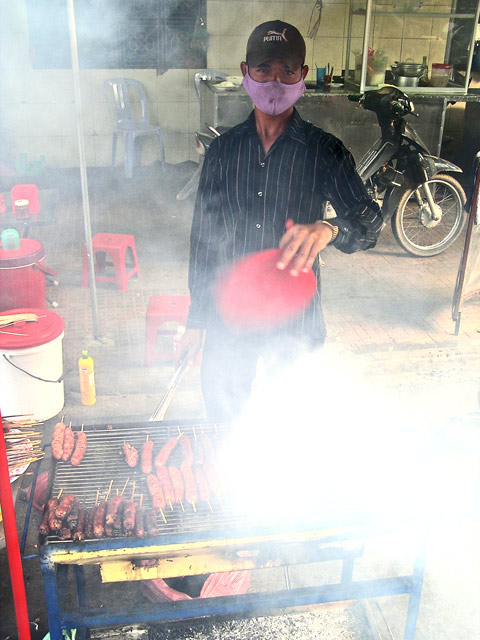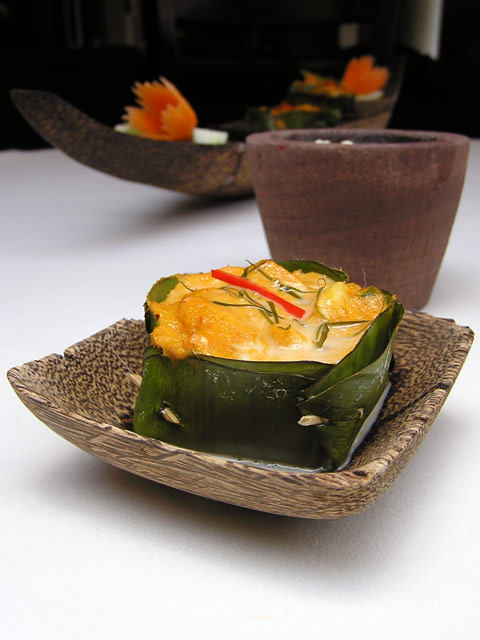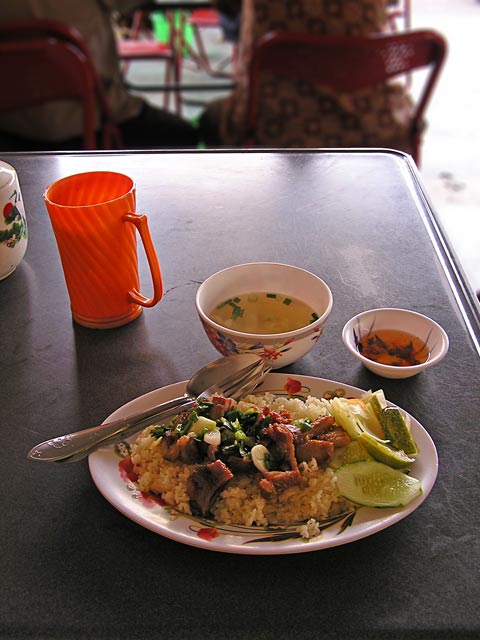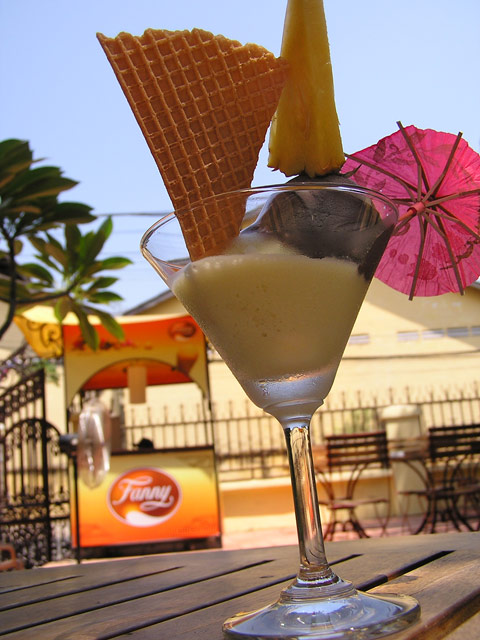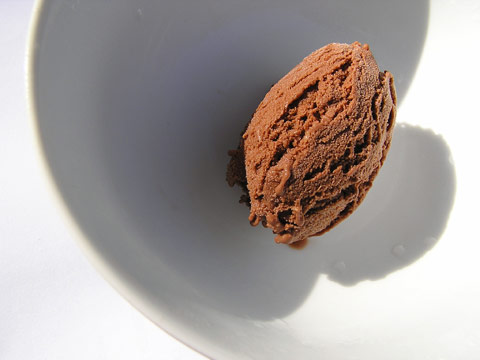Reader quiz: what the hell is the above vendor doing? And does he get to lick his arms afterwards?
Category: Phnom Penh
Live from Cambodia’s Capital
Dirty street charcuterie
Cambodians are world champion charcutiers. What the locals lack in quality produce, they make up for in sheer volume and world-beating determination. A Cambodian household that doesn’t dry its own fish, meat scraps or leftover rice is rarer than one that doesn’t enjoy the sublime beauty of prahok. Everybody knows how to sun-dry their own ingredients: probably the best way to spot a non-Cambodian household is to pick the one without a tray of leftovers soaking up the sunlight at the front of the house. It’s a response to the seasonal nature of Cambodian food. The frequent boom and bust cycles of local agriculture and fisheries have forced everyone to develop a taste (and huge amounts of skill) for preserving everything that they can eat.
The Cambodian sausage is much maligned. It’s palm sugar-sweet, composed of half pork gristle and half pork fat, sometimes a touch of chilli for color, sold grilled on the dirtiest streets imaginable. They are inspired by Chinese sausages (laap cheong(?)) but will also be sold as small ball-shaped sausages as well as the more recognisable links. Vendors make their own links which they hang from a clothes rack to semi-dry before barbequing over hot coals. While hanging, the sausages pick up a little of the smoke-flavour from their charring compatriots as well as a good deal of dust from the road. Of all Cambodia’s streetside foods not deliberately involving fermentation, this is the one that I approach with the most trepidation.
The above sausage was served on a stick; a one-handed food in the parlance of modern convenience cuisine. More often than not, it is plated up with a basic pickle of shredded green papaya, carrot and vinegar that slices through the sausages’ sweetness and fattiness.
Location: Near Psar Chas, Phnom Penh. 500 riel per stick.
Amokalypse Now: Gratuitous food porn edition
The above photo is the fish amok from Malis restaurant in Phnom Penh : the same amok that I shot for the Wall Street Journal article. I expected that they’d use this photo rather than the one that they did : this is about as well as I can capture gratuitous, selectively-focused food porn without resorting to either Adobe Photoshop or a full-time photographer. The only food styling that I performed was to place a paper napkin under the banana leaf to soak up some of the wayward coconut milk. Otherwise, this is the amok that Malis serves every day.
Location: Malis, Norodom Blvd, just south of the Independence Monument.
See Also: Real Khmer? Cambodian Fine Dining in Phnom Penh, Seeing how the other half lives – Malis and Pacharan
Won’t you take me to funky town?
Traditional whipping boy of the Cambodian expat dining scene, the Foreign Correspondents’ Club, has hired Clinton Webber as new Group Executive Chef to overhaul its menu.
“It’s going to be a whole new thing,” says Webber. “There’s going to be lots of fusion and touches of Khmer cuisine. The emphasis is on being more funky. Think funky, rustic fusion.”
When I think funky, rustic fusion, I think of George Clinton playing a banjo.
See: FCC
Pork and Rice: The national breakfast.
There are four types of Cambodian breakfast: pork and rice (bai sach chrouk); noodles (mee cha) or noodle soup (khtieau); rice porridge (bobor); and the improvised foods of those who are starving and eat whatever they or the World Food Programme can unearth. At a rough guess, these groups equally split the population (with an outcast minority such as me who tend to only eat breakfast on weekends and therefore try to make it as decadent and calorific as humanly possible. In the view of most Cambodians, my diet is not so much unbalanced as it is unhinged; and thus somewhere outside orthodox classification).
The standard Cambodian pork and rice set is as follows: any boneless cut of pork, thinly sliced and barbecued on a wire grill over warm coals then served with a hefty plate of broken (or just cheap) rice. The pork is sometimes marinated in garlic and oil, but more often than not, is just cooked slowly over the fire to soak up the fat-induced smoke. The side is invariably pickles, most commonly cucumber. The below pickles were a piquant mix of fresh ginger, cucumber with still a hint of crispness and paper-thin slices of daikon radish.
The set will include a bowl of thin chicken stock from the noodle soup master stock, topped with spring onions, and a dipping bowl of sweet chilli sauce (tuk mteis). The method of eating the stock is to either eat it uncut or take a small spoonful of rice and then top up your spoon with a little stock. The above chilli was blindingly hot which is a real rarity, because the sweetness tends to outweigh the capsaicin.
If cutlery is not already present on the table, then it will arrive in cup full of steaming and sterilising water (orange and plastic, above) and the correct etiquette is to wipe down your knife and fork with a provided napkin or toilet paper, disposing of the paper on the floor or into a provided tableside bin. Do not under any circumstance drink the water in the sterilising cup.
The eateries are at their busiest from 6:00am until 8:00am, as most locals have seemingly been up since sunrise and need a huge carb-and-lard boost to get them through to the interminable hours until the midday meal. When busy, all tables are considered communal. It is perfectly acceptable to intrude on anybody’s table and engage them in your wittiest repartee. My Khmer wit is extraordinarily limited, although everyone gets a laugh out of how I can’t properly pronounce the word for ‘glass’. Unlike Vietnam or Thailand where small breakfast vendors often lack tables, a Cambodian pork and rice vendor without seating and a rudimentary bench is an exception. Where the tables are not built from the thin metal, they are covered with a garish vinyl tablecloth which is either geometrically patterned or provided as an advertisement from a large soup or monosodium glutamate manufacturer.
By 9:00am, breakfast will be over. Small pork and rice joints will disappear entirely to be replaced by lunchtime soup, fish and rice vendors. Brunch is not an option.
Location: Pictured pork is from my coffee roasting friends at the corner of Street 432 and 155, but there is a pork-charring crew on practically every Phnom Penh side street in the mornings. The best guide to picking a great bai sach chrouk vendor is finding one where the barbecue is still smoking and pork is served directly from the grill to your plate. Most vendors buy their pork daily (as a cashflow issue rather than not having proper storage) and so freshness is guaranteed.
Continue reading Pork and Rice: The national breakfast.
It’s grim up north
Its undoubtedly the liveliest and most popular Korean restaurant in town. Packed for lunch and dinner, the Pyongyang Restaurant is famous not only for its cold noodles and barbecue served with kim chi, but also for its talented wait staff, which when not serving are dancing to traditional Korean tunes played on violins and electric piano.
But the Pyongyang Restaurant in Cambodia’s capital Phnom Penh is no ordinary Korean eatery. For one, it’s owned and run by the North Korean government, a capitalist enterprise that sends its profits directly to state coffers in Pyongyang.
Asia Times’ Bertil Lintner covers the geopolitical implications of Phnom Penh’s weirdest food attraction: the North Korean-owned and run Pyongyang Restaurant. This seems to be the only Cambodian eatery that plays the food-as-propaganda angle, and does a roaring trade attracting South Koreans into its razor-wired compound. Not much mention of the food but plenty of juicy political tidbits to make it worthwhile.
See: Asia Times’ Dining with the Dear Leader
Phnom Penh delivery menus: Antisocial expatriates rejoice!
Fresh from the Ministry of “I wish I’d thought of this first” , Cambodia Pocket Guide has just made every housebound expats’ dreams a reality and started publishing delivery menus for their various advertisers around Phnom Penh.
Current online offerings include:
- Alley Cat Cafe ("Western"/Mexican) – Much to the dismay of my arteries, I heartily recommend their chilli cheese fries and their (nondelivery) Tuesday night ribs.
- Chez Dim (pizza)
- FCC (Burgers, "tapas", "Cambodian", pizzas)
- Fresco (Sandwiches, salads, coffee, smoothies) – my review
- Garden Center Cafe (Western, vegetarian)
- Java Cafe (Sandwiches, meat, burgers)
- La Volpaia (Italian)
- Lemongrass (Thai)
- Luna d’autunno (Italian)
- Open Wine (Wine, "meat")
- Shanghai (Western, thai, and grill)
- Sharky (Tex mex, burgers, Thai)
- The Deli (Bakery, breakfast, sandwiches)
- The Shop (Cakes, breakfast, sandwiches)
Cambodia’s Yellow Pages also contains a food delivery section – only the first thirty or so listings marked with a star have menus for take away/delivery.
The pornography of tropical ice cream.
Ice cream in the tropics is pornographic. There is a moral wrongness about consummating your lather of hot season sweat with something cold and creamy. It’s a fleeting pleasure riddled with First World guilt. What’s more it’s for sale, quite openly, on the streets of Phnom Penh. Presumably, ice cream arrived in Phnom Penh with the French colonisers and has since become popular with the colonised as a street food (which I have covered previously in both a microbiological and more sociological sense). What has changed within the past year is the opening of a handful of upmarket establishments, pimping their rich flavours to richer Phnom Penhois.
Fanny at Open Wine
Any locals fearing a Vietnamese invasion be warned: advance troops have been sent to pervert the local population with their seductive iced treats. While the name may refer to an Australian slang term for female genitalia, Fanny is actually an offshoot of a well-established Saigon ice creamery rather than a more disreputable local establishment selling their namesake. Painted in the same mustard palette as their partner over the border with the same menu and wrought iron furniture, the only concession to Cambodian preferences seems to be the covert removal of any reference to Vietnam from the marketing collateral. Their garden seating area looks a little worse for wear by day, but classier by night when the fairy light bedecked palm lights up.
With twelve flavours of ice cream on offer and eight sorbets (including local seasonal flavours of passionfruit, durian and mango), I was only left with one choice: order the ice cream modelled into the shape of a cyclo (US$3.50). After a short negotiation with my assigned waitress, it was revealed that a vital component to the dish, the slices of orange for the wheels, had run out, so I settled for a much more prosaic scoop of mint and dark chocolate (pictured above). The mint had an industrial mint essence quality and contained the ice crystal warning signs of being defrosted then refrozen; the dark chocolate was foamy, fatty and mousseline.
Price: $0.75 per small scoop
Location: In Open Wine, Street 19 just north of the Street 240 corner. Open Wine also has a magic barbecue that transmutes animal flesh into timber: if you’re planning to eat there, pair your wines with ice cream. However, their meat-centric antipasto platter is a great accompaniment to a celebratory bottle of brut de brut.
Bong Karem
Bong Karem is a welcome newcomer to the Street 240 tourist strip because unlike practically every venue on that street, the food is outstanding. Sixteen flavours of gelati taunt you at the front counter and Karem will offer custom flavours to larger orders. I foresee a bold future for personally designing Kampot pepper, fresh turmeric and galangal gelato. The small shopfront lacks seating which is a huge drawback in hot season when you’ll be left with a fistful of sticky cream within minutes of exiting the store.
Bong Karem’s cones are fresh and they pad out their local fruit range with rarer imported flavours such as hazelnut. I hit my personal gelato favourite (cocco) which entrapped the refreshing tartness of green coconut milk with a few slivers of desiccated flesh mixed throughout, and the matching ciocolata (chocolate) was fully rounded with a slightly grainy cocoa mouthfeel.
Price: $1 per scoop
Location: #57Eo, Street 240 (map)
Vergers D’Angkor
Vergers D’Angkor is a hotel/restaurant supplier and Cambodia’s oldest artisanal ice cream producer, but doesn’t have a parlour befitting of its own product. Their dark chocolate (pictured) was more anorexic than Karem’s or Fanny’s and had suffered a little in storage at Comme à la Maison’s small delicatessen. When I find a fresher punnet, I will do them the justice of a better review.
Price: $3 for a 250gm punnet.
Location: Available from Comme à la Maison, #13, Street 57.
See also: Mobile Ice Cream: Droppin’ Science, Ice cream Sandwich on Wheels, Paucity of Phnom Penh Power: Ice cream in Crisis
Phnom Penh is the “Next Prague”
So sayeth the New York Times in their most recent run-of-the-mill review of Phnom Penh by Stuart Emmerich, who managed to cover the town with his parachute still attached. On matters of eating, he lands a few blows to the doughy belly of the Foreign Correspondent’s Club (“undistinguished (at best), and the toothache-inducing fruity drinks should be passed up in favor of a cold bottle of Angkor Beer”) and displays a complete inability to do the most basic research on restaurants in this strange, foreign country:
For truly authentic Khmer cuisine, one must go to nameless little places all over town where you’ll spend less than a dollar — but it might not be advisable to ask just exactly what this meat you are eating is.
It’s whatever meat you ordered. And here’s a list of the names of 870 restaurants in Phnom Penh, all in English, from the Cambodian Yellow Pages. They shall not remain nameless.
See also: NY Times’ In Phnom Penh, Hopefulness Replaces Despair, Sihanoukville is the next Goa, Sihanoukville is the next Goa 2: Electric Boogaloo, Sihanoukville is the next Goa III: Beyond Thunderdome
Made by small hands
I am always reluctant about taking photographs of children even though they play an integral part in the production, sale and capture of Cambodian food. In part, it’s a consent issue. Partly, it is because I don’t find children interesting and don’t want to despoil my camera of valuable bytes with them. Thankfully, there are more nuanced approaches to capturing kids at work, such as the upcoming exhibit by Jerry Redfern, the other half of Rambling Spoon. He is exhibiting his shots of working Cambodian children, opening at 6:30 pm, 10 February 2007 at Le Popil Gallery in Phnom Penh. Sneak preview at his website.
Above shot is mine, from a roadside stop on the outskirts of Sihanoukville.
